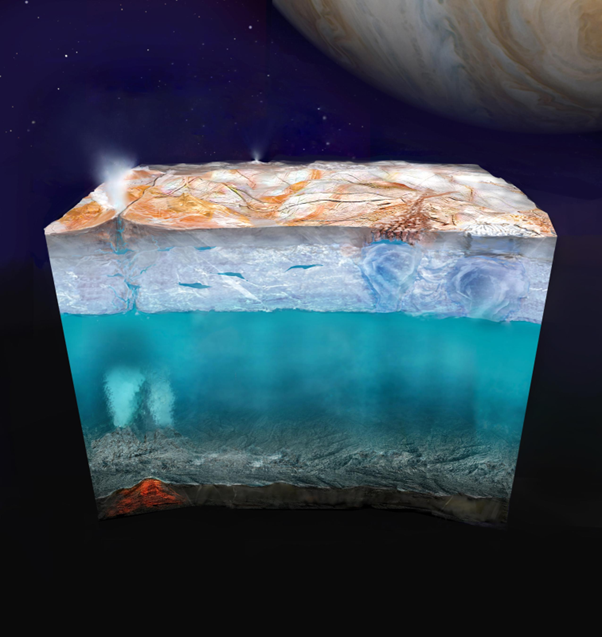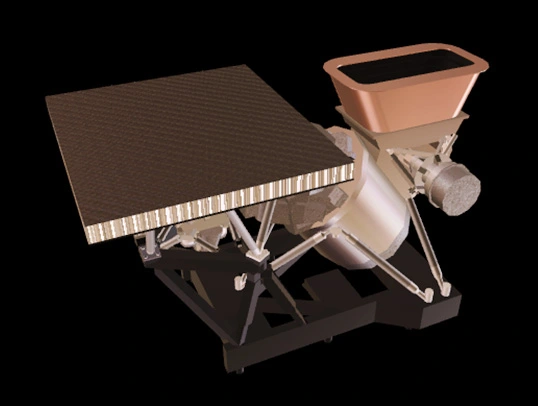Europa Clipper
NASA’s Europa Clipper is going through its final tests! The planned date of launch is the 10th of October this year. But what is the Europa Clipper? And what will it be doing?!
Why Eurpoa?
The icy moon Europa sits 730 million km away orbiting the giant gas planet Jupiter. Jupiter is a planet of many moons (the current count is around 95), but Europa is of particular interest to scientists because it is believed to be one of the most likely candidates for extraterrestrial life in our Solar System.
There are several lines of evidence that have led scientists to believe it has an ocean of water beneath the surface. It began in the 1970s when spectroscopic observations of the moon showed first that the surface was mostly made of frozen water or water ice. At the time it was theorised that underneath the surface there could possibly be liquid water.
The main piece of evidence didn’t come around until NASA’s Galileo spacecraft, which orbited Jupiter from 1995 to 2003, found that Europa has an induced magnetic field which suggests that under the surface there is a conductive layer. This is likely to be a salty liquid ocean. We think that due to Jupiter’s strong gravitational pull, the pushing and pulling between Jupiter and Europa – or tidal friction – causes the planet to heat up to allow an ocean to form beneath the icy crust.
On Earth, where we find water, we find life. And we think it will be the same for another place (at least life as we know it). Europa is possibly our biggest hope of finding somewhere in our Solar System with a habitable environment.

Credit: NASA
The Mission
Europa Clipper is an orbiter spacecraft meaning it will not be landing on the surface of Europa. Although that may seem like it won’t help an awful lot, it’s designed so it can still gather lots of information about this icy world. A future lander is still on the cards, and if Europa Clipper is successful in its mission we may well see it launched in the near future.
The main science goal is to determine whether there are places below the surface that could support life. To do this it is going to look closely at the nature of the ice shell, the ocean below and also the composition and geology.
How will they do this without even stepping on the moon I hear you ask? The spacecraft will be performing almost 50 flybys over the course of its 4-year science phase, each one over a different location so that NASA can get a good look at almost the entire moon.
The Spacecraft
It is the largest spacecraft NASA has ever sent for a planetary mission. Because Jupiter is so far away, a much smaller fraction of the Sun’s light reaches the planet, about 3-4% of what Earth gets to be more precise. To make enough energy, it needs huge solar arrays. The whole spacecraft has a diameter of 30.5 meters, and a whopping weight of 3,241 kg. With all that being said the arrays are still only producing roughly 700 watts of electricity when orbiting near Jupiter, which is just enough to operate a sandwich toaster.
Going near Jupiter is quite a dangerous place to be! Jupiter has a humongous magnetic field which traps charged particles from the Sun and other Jovian moons such as the very volcanic moon Io. The magnetic field speeds them up like a particle accelerator making them extremely dangerous. This means that a day’s worth of radiation on the Europan surface would be enough to kill a human! To keep the electronics and payload safe it will be enclosed in a thick protective vault made of titanium and aluminium. This should shield them from most of the high energy particles!

Credit: NASA
Europa Clipper will be taking several instruments with it to complete its scientific goals:
- Europa Imaging System (EIS) and Europa Thermal Emission Imaging System (E-THEMIS)- These will be used to map out the surface and look at the warmer regions for signs of liquid water or recent activity.
- Europa Ultraviolet Spectrograph (Europa-UVS) and Mapping Imaging Spectrometer for Europa (MISE)- These will look at the composition of its atmospheric gases and the surface.
- Europa Clipper Magnetometer (ECM) and Plasma Instrument for Magnetic Sounding (PIMS)- The ECM will look in depth at its induced magnetic field to confirm if the subsurface ocean exists, how deep it is and its salinity. It will also measure the thickness of the ice crust. PIMS will distinguish distortions caused by Jupiter in Europa’s induced magnetic field.
- MAss Spectrometer for Planetary EXploration (MASPEX) and SUrface Dust Analyser (SUDA)- MASPEX will analyse gases to study the chemistry of the subsurface ocean, as well as to understand how the ocean and surface exchange material, while SUDA will be analysing any dust that comes off the Europan surface.

Mapping Imaging Spectrometer for Europa (MISE) Credit: NASA
How long?
If all goes well the spacecraft will be arriving at Jupiter in 2030, so we will have to wait at least 6 years to find out if there could be possible life in the Solar System. On its way it will be doing flybys of the planet Mars and Earth. We wish Europa Clipper the best of luck in its journey. Bon Voyage!
Author: Rosie Braunholtz
















